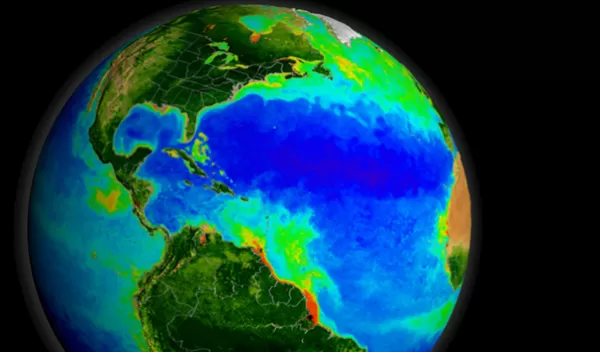
New model sheds light on day/night cycle in the global ocean
Phytoplankton are the foundation of all life on the planet. Understanding how these photosynthetic organisms react to their ocean environment is important to understanding the rest of the food web.
But computer models of the global ocean biogeochemistry typically don't include the day/night, or diel, light cycle, even though that cycle is critical for photosynthesis in the ocean’s primary producers.
For the first time, U.S. National Science Foundation-supported biologists at the Marine Biological Laboratory in Massachusetts have incorporated the diel cycle into a global ocean model in order to investigate its effects on phytoplankton.
The study, published in Global Ecology and Biogeography, is the first to investigate how the day/night cycle affects the biogeography and diversity of these primary producers. The research took place in part at the Plum Island Ecosystems Long-Term Ecological Research site, funded by NSF.
The model offered natural light and dark cycles over the global ocean to 15 simulated phytoplankton types. The simulations then compared to a control simulation using the same plankton model, but illuminated with light averaged over 24-hour periods. The goal was to see how diel light cycles affected phytoplankton productivity and changed nutrient concentration dynamics.
The simulated phytoplankton were all different cell sizes and separated into two different groups with two broad ecological strategies. "Gleaners" simulated smaller cells with high nutrient affinity (meaning they could capture nutrients out of the water column even if those nutrients were in low quantities) but slow growth, and "opportunists" simulated larger cells with higher maximum growth rate but low nutrient affinity (meaning they did better in nutrient-rich water). These were representations of real phytoplankton based on parameters from lab cultures.
The researchers found that the diel cycle did indeed matter to the simulated phytoplankton.
The model showed that diel cycles are associated with higher concentrations of limited nutrients, which meant that at lower latitudes (40 degrees south to 40 degrees north), the simulated opportunists were more abundant than the gleaners compared to the control simulation. This includes phytoplankton like diatoms. This mechanism became less important at higher latitudes, where the effects of the seasonal light cycle were stronger than the day/night cycles.
If scientists don't understand how phytoplankton are getting their energy as primary producers at the base of the food web, it's hard to make inferences about the interactions of the rest of the global ocean food web — all the way up to humans.
The global ocean is huge, and so are the models that represent it. To grapple with the complexities of what happens in the ocean, modelers often simplify certain processes. Typical models incorporate only seasonal light shifts rather than adding the more fine-grained details of the day/night cycle. This is mostly a computational decision, says Joe Vallino, senior author on the paper. "If you're not resolving fine time detail, in general, [the models] run faster."
Understanding how the ocean works is vital for understanding how global warming and elevated carbon dioxide affect climate change. "This model contributes to advancing our understanding of how the ocean works," says Vallino. He adds that as scientists make better ocean models, eventually they may use them to investigate possible solutions to climate change while minimizing unintended consequences.
"Being able to predict how the distribution of phytoplankton will change has repercussions higher up the food web," says Vallino. "If you can't get that base change right, you can't get anything that's connected to that above it right."


